(read Part 1 here)
When we were visiting a temple, Agung drew my attention to one of the pavilions near the entrance.
“This is where the cockfights take place,” he explained.
“Cockfighting, here?” I asked, surprised. “What for?”
The basic reason was not entertainment, my guide hurried to clarify. On the contrary. The cockfights had a sacred purpose, and they were even mandatory on major holidays and religious festivities. They were originally a form of animal sacrifice, acting as offerings to evil spirits, to appease them so as not to trouble the ceremony scheduled for that day. Of course, the stated purpose did not make the custom less cruel — which is why the fights were usually attended only by men — nor less popular outside the religious context.
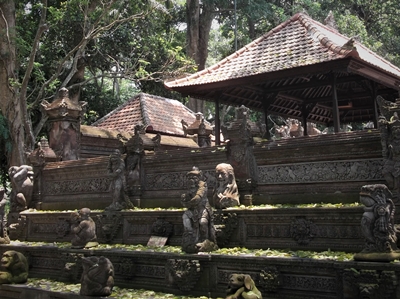
As we passed through a village, I noticed a large group of people in procession, accompanied by a sort of brass band. The cheerful sounds and the percussion rhythm made the whole event borrow something from the atmosphere of a carnival.
“What’s this?” I asked Agung, delighted with the sight. “What are they celebrating?”
“It’s a funeral procession,” he told me, as serious as he could be.
His answer wiped immediately the smile on my face. Under no circumstances would I have guessed such a thing. I tried to look more closely, but I didn’t see anyone crying.
“It’s normal,” Agung explained to me, “for us, death is a relief, and we must rejoice for the soul that is going to a better world.” The cremation ceremony is a happy one.
“But what’s there, in front of us?”
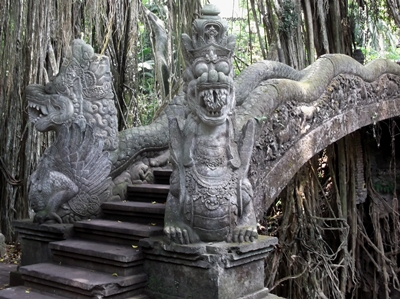
I pointed to what looked like a giant, red dragon.
“That’s … the coffin,” Agung replied. “It is a Barong, a mythical animal that carries the soul to nirvana.”
He explained to me that the body of the deceased was to be cremated in the belly of the Barong. The whole community participated in the ceremony.
“No one should cry,” Agung insisted.
“Easy to say,” I thought, deeply disturbed by the contrast between the nature and the appearance of the event. True, there was a certain degree of serenity floating in the air, which would not have been possible if everyone had mourned openly. However, many looked exhausted, because the preparation for the ceremony was long and expensive, as Agung revealed to me. A hidden sadness, suppressed by a noble detachment, weighted visibly on people’s emotions. After all, a human’s reaction to death is naturally one of fear and pain, and whatever nature has planted in us is difficult for reason alone to eradicate or sublimate. Religion tries to educate this reaction and, in the light of the beliefs it cultivates about the afterlife, to transform it. It is not a small thing if it succeeds in helping people suffer less, and eventually accept the situation.
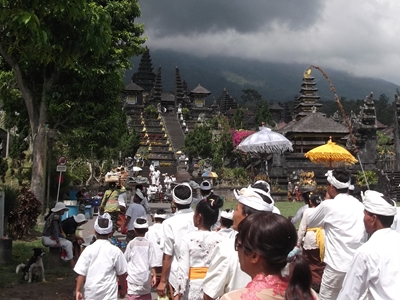
“The saddest ceremonies in our country are not the funeral ones”, Agung wanted to clarify.
“Which one is the saddest?” I asked, curious.
“The New Year!” he answered promptly, as if to continue the series of paradoxes.
Agung further disclosed that, unlike the way in which the rest of the world celebrated the New Year — that is, through parties and entertainment — in Bali the event was marked by fasting, silence and introspection. The last day of the Balinese calendar, a date that varies from year to year, imposes an absolute ban on eating, drinking and talking.
“You’d better not be in Bali during Nyepi,” Agung told me. “That’s how we call the New Year’s eve. The airport is closed, and so are the roads and beaches.”
Because it was a day dedicated to meditation, he explained to me, any activity that could disturb this goal — travel, work, fun of any kind — was suspended. Moreover, special police teams in charge of protecting the local traditions made sure that the prohibitions were respected, by locals and tourists alike, including by imposing fines.
We were nowhere near Nyepi time, so I breathed a sigh of relief.
On our way back, Agung stopped at a coffee farm. He didn’t say anything, just:
“Go inside. It’s something special. You’ll see.”
And he could barely hide a mischievous smile.
I was immediately greeted by a small young woman, wrapped in a brightly colored sarong , who offered to introduce me to the coffee-making process on the farm. It was the most expensive coffee in the world, she told me.
I would have thought that Agung was sending me to a regular coffee plantation, and the varieties cultivated there emerged from classical agriculture. Instead, I would find out that the secret of that special coffee was not related to plants, but to … animals.
The key to obtaining the famous Luwak coffee was a small wild cat, round-eared and furry. Those civets were fed coffee beans, which apparently they enjoyed eating. Once ingested, the grains underwent a process of fermentation with the help of some special enzymes, which caused a reduction in their acidity and caffeine content. What happened next was not hard to guess: the beans were recovered from the animal’s feces, then washed, dried, roasted and … prepared as coffee. It was said that the passage through the animal’s intestines gave those coffee beans their unique flavor.
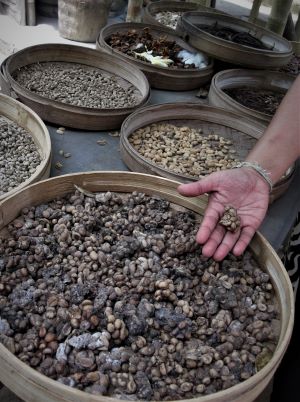
The preparation of Luwak Coffee
To some like me, though, it sounded more like an irony. In my mind, the coffee could in no way be dissociated from the sight of the animal defecating in its cage, and this involuntary prejudice proved to be stronger than any curiosity. So I did not taste the most expensive coffee in the world. Instead, I had some hot chocolate and ginger tea, which were offered as consolation to those with a more rebellious stomach.
It was already evening when I arrived in the island’s ancient capital, Ubud. The rainy season had just started, the heat and humidity were at their peak, and the afternoon rain showers were getting longer. Most of the tourists had left already, and some places were almost empty. New in town, I got lost on some deserted little streets, mostly immersed in darkness. Here and there, a dim light was disclosing the presence of a tavern or shop.
At some point, as I was getting hungry and tired of walking around, I noticed a small restaurant that seemed better lit and more animated, so I went in.
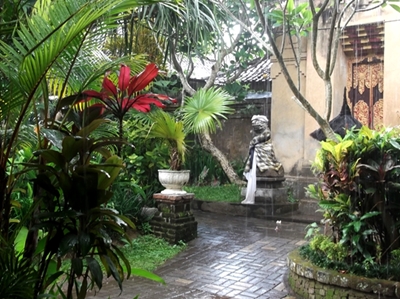
While I was checking the menu, I noticed that the walls were full with pictures and something that looked like proverbs or quotations. When I looked closer, I saw the words: “Eat, pray, love.” I realized quickly that the whole place was full of quotes from the book and pictures from the movie, even seeming to imply that the author of the book herself used to come there. I don’t know if it was true or just a way to attract customers, but I remembered that one of the key episodes of the book, the one that changed the writer’s love life, took place in Bali, more precisely in Ubud.
The much greater surprise was for me to notice, as I looked around a little better, that the restaurant’s guests at that moment, without exaggeration, were almost exclusively single women, aged between thirty and forty, just like Elizabeth Gilbert when she was there … and, unfortunately, like me as well, an accidental passer-by. I realized immediately the power of the local myth that attracted every year single women in search of meaning and balance, while secretly hoping that they would find love in Ubud, just like the author of “Eat, Pray, Love” did.
The very next day, somebody offered to take me to a shaman. The proposal was not innocent. Because Elizabeth Gilbert had written in her book about a wise shaman whom she visited frequently, many of the lonely tourists who came to Ubud wanted to get to the same person.
“You need to book an appointment three months in advance if you want to see him,” the guy explained to me. “Because the book made him famous, he is now very busy. But no problem, he assured me, if you want a shaman I can take you to somebody else, no less reliable.”
When I found out that he intended to take me to his shaman friend by motorcycle, at nightfall, through some remote villages, and it was not clear at all how I would come back and what kind of rituals I would be dealing with, I did not hesitate to decline the offer. I would not have imagined that, in just a few years time, I would attend a shamanic ceremony, in the middle of the night, in the heart of the Amazon jungle…
Not far from Ubud, there were several villages particularly well-known for their traditions. I had read that each village had its own signature craft, practiced by most of the inhabitants and passed down from generation to generation. My imagination was about to be humbled, again.
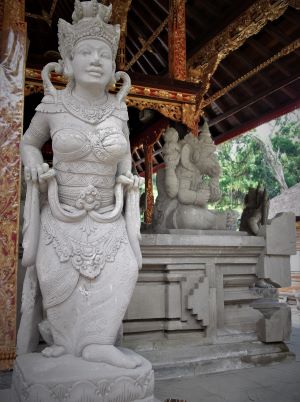
Balinese statues
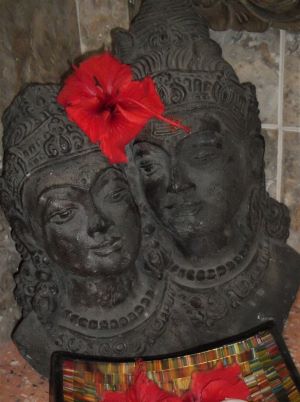
In the stone carvers’ village, all the courtyards were literally packed with stone statues of all sizes, of the kind that I had seen in temples or gardens, while the local craftsmen could be seen at work in front of their houses. In addition, hundreds of statues were on display on both sides of the road, for the potential buyers. The wood carving village was a miles-long, open-air exhibition containing the beautiful frames and doors that typically decorated the Balinese houses, together with myriads of statuettes representing various deities: Rama and Sita, the legendary couple from Ramayana, Ganesha, the elephant-headed god, or the goddess Saraswati, the protector of arts, music and teaching. They were sculpted, with various degrees of precision, in different types of wood: some in a white, soft wood that the locals called crocodile wood, others in mahogany or ebony, and the most expensive ones, in sandalwood. Finally, the village specialized in hand-painted fabrics — the traditional technique called batik — hosted genuine art collections. Many of the compositions painted on silk or cotton were incredibly elaborate, exceeding by far the level of mere pattern design.
Nowhere had I seen so much respect for traditions, and so much dedication in cultivating them. From what I was told, the craftsmen offered their knowledge for free to all who wanted to learn, and they were proud to do so. They weren’t concerned at all about potential competition, on the contrary.
In Bali, even something as trivial as a rice field could be made into a work of art.

Balinese rice fields
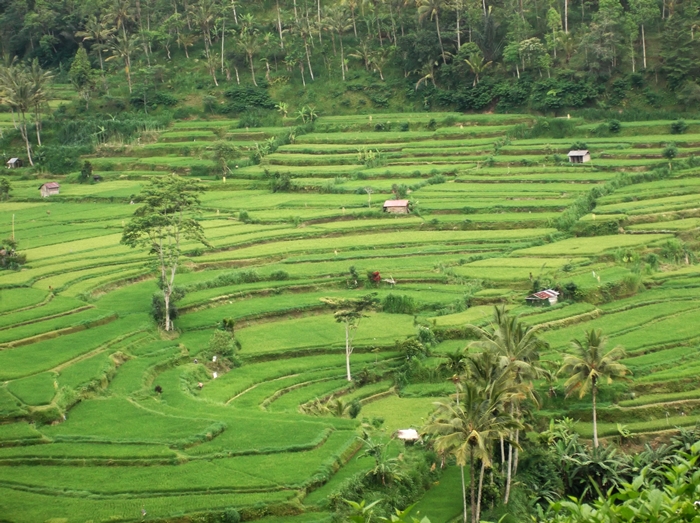
The rice grew on hills separated by deep valleys, and the terraces followed the curves of the hills so closely that from a distance they looked like waves, drawn with lines worthy of the finest engraving and superimposed in dozens of layers. Here and there, the steep slopes were marked by clusters of coconut or banana trees, as well as small shelters or huts with thatched roofs. The green color of the rice had an almost hypnotic effect. Under the fast changing sky, the shade cast by the clouds gave it unexpected depths, in dazzling contrast with the brightness of the fields that bathed in sunlight.
The irrigation system of those fields had been designed in the ninth century under a concept known as subak. The wisdom behind that concept had ensured for centuries the sustainability of water and land use, along with the protection of the ecosystems. The tradition of rice cultivation reflected the same local beliefs that informed Balinese architecture, which were meant to ensure the harmony between men, gods and nature.
On the “island of gods”, beauty was much more than an aesthetic attribute. It was an overarching principle and a living force. Through its many forms and subtle presence, it acted like a genuine therapy for the soul.